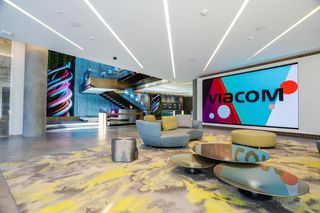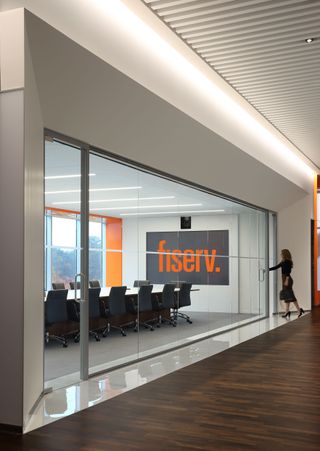Back in the day, installing AV in a corporate environment was relatively simple. Integrators would show up, install a projection and sound system in a few meeting rooms, and the job was done. Today, the landscape of corporate installations has totally changed. These massive entities sprawl over entire campuses and are highly concerned about the experiences of employees and visitors—and they are loaded with AV, from lobbies with digital signage, to huddle rooms for impromptu meetings, to large auditoriums for all-hands meetings.
The challenge of the pervasiveness of AV is one familiar to Scott Walker, CTS-D, president, Waveguide. “AV is no longer relegated to just sound, video, and control in formal meeting spaces,” he said. “AV now encompasses digital signage, wayfinding, room scheduling, unified communications, sound masking, smart building controls, interior and exterior LED video walls, and much more. It’s not uncommon for a corporate campus AV package to include many hundreds of AV spaces valued in the tens of millions of dollars.”

From the Ground Up
“We need to be able to get into the project earlier” is a phrase often heard in the integration community. Architects will sometimes spec in particular products without realizing that product is not a fit for the space—and sometimes that product may even be obsolete. How can integrators and consultants prevent that from happening?
“Integration, by definition in business, is the process of attaining close and seamless coordination between several departments, groups, organizations, and systems,” said Michael Johnson, senior account executive, McCann Systems. “Integrators should not wait for these other key players to come to them; they should be proactive in attaining and maintaining these relationships.” Simply put, integrators should work their networks to be involved as early as possible and to ensure relationships with key players are “open and collaborative.”
[Learn more about working with architects at the AV/IT Summit.]
Another aspect to focus on, according to Walker, is educating everyone involved. “While consultants should always strive to have healthy relationships with architects and space planners and remain humble in understanding the vision these designers have for the project, ultimately, it is our responsibility to stand up for the functional aspect of the corporate campus,” he said. “The owner is building this campus to do the business of the organization. Yes, the campus needs to be visually appealing, but it needs to function too.
“Physics always wins, and while there are always better and better tools being developed to overcome some physical challenges, designing the campus upfront for long-term success is better than hoping there will be some magic technology by opening day that will overcome excessive reverberation, too much ambient light, too low of a ceiling for good sightlines to a properly sized image, etc.”
[How to make acoustics work in open office environments.]
Bringing facts and science-based evidence to the table before decisions are made by architects and clients helps, too. Walker said that this approach could even save the client significant money by not having mistakes to fix after opening day.
The New Normal
Office life has changed over the past few years. No longer does an employee come in, sit at the same desk every day, and leave at 5 p.m. on the dot. There are permanent work-from-home positions, sales reps on the road, or those who hotdesk. No matter what the situation, corporations need all employees to have access to clear communications—and be plugged into the latest and greatest AV technology, of course.
“Corporations are embracing work-from-home policies while also seeking technologies and amenities to attract employees to the office to be productive and collaborate with colleagues,” said Walker. “AV technologies are a major part of the solution to make people want to come to the office.”
AVIXA’s IOTA report says that a “growing faction of corporate America is attempting to create more innovation by bringing employees back to home base. AV technology implementation is the way for companies striving to make the office ‘the place to be,’ in part by improving user experiences.”
“The employee and guest experience has become an exploration of their entire workday journey,” Walked pointed out. “From the time employees or visitors arrive on campus, park their car, make their way to their designated building, and pass through security, AV can make each of those experiences more user-friendly, and that’s before a meeting even starts. AV is vital to the operations of the company.”
Something that may surprise people is that office furniture is becoming part of an integrator’s territory, Johnson said. McCann has “accommodated more custom hotdesking furniture into our designs, and/or coordinated more efficiently with furniture and space planning departments to ensure the correct solutions for their workforce.”
In terms of hotdesking, Walker said plenty of companies are “striving for a single mobile app that allows their workers to visit any office in the enterprise and find a workspace for the day, reserve a locker, book a meeting room, etc., and meet with their associates in person or virtually with a few button presses on their phone.” Hotdesking—even if you’re not dealing with the furniture—opens up the opportunity for an AV upsell, like adding kiosks for reservations and wayfinding, he added.
Meeting Rooms
Meeting rooms can be a pain for workers: scheduling issues, not understanding how to use the technology, etc., can lead to unproductive gathering.
During an installation, room/resource scheduling often becomes “a mini project itself within the larger project,” according to Walker. The scheduling can be part of the aforementioned single mobile app or it can go “far beyond the confines of one building” and become an enterprise-wide standard with global rollout implications.
[Getting a Handle on the Huddle Space]

Once employees understand the scheduling system, the next challenge can be getting them into rooms that work. “The ability to successfully work from anywhere has ushered in a need of getting people together in a room from time to time—and flying them in is not an option,” said Johnson.
The collaboration trend, he said, “has correlated directly to the size and volume of conference rooms.” Companies no longer have just a few large conference rooms. While a small number of large rooms remain for bigger gatherings, walking through a modern campus, you’ll notice smaller huddle rooms dotted around the buildings. This change, Johnson added, is due in part to the price reduction of flat panel displays. “Campuses have more small conference rooms, open collaboration spaces, and huddle areas in their overall design compared to five years ago.”
Big Business
With new norms in the workplace—like huddle rooms, hotdesking, and lobby experiences—it’s no wonder that the corporate market is booming for integrators. In fact, according to AVIXA’s IOTA report, pro AV solutions in corporate environments in the Americas were expected to generate $15 billion in revenue in 2018.
“AV is now mission critical,” Walker concluded. “The technology solutions we provide have a massive impact on the company’s ability to do business.”













